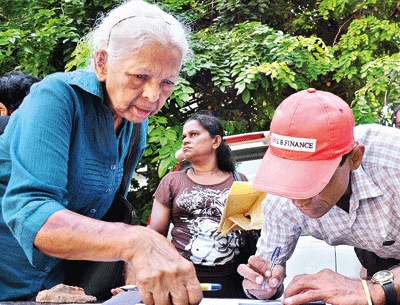Government faced with GK assets sale after settling depositors money

File pic of a GK despositor lending her name to a campaign to recover deposits
After almost eight years of dreadful suffering, Golden Key (GK) depositors with deposits of Rs.10 million can breathe a sigh of relief with the government’s decision to repay the 3rd and final tranche of the 41 per cent repayment of their total deposits partially ending the money swindling saga of Lalith Kotelawala and his clan.
However the Treasury along with the Central Bank is still confronted with a major task of recovering the sum of over Rs. 8 billion public money allocated for this repayment process on the directive of the cabinet of ministers by disposing now available assets of the defunct credit card company.
The repayment process comes to an end with the cabinet decision to release Rs. 4.05 billion from the Treasury to the Central Bank for the completion of the 3rd and final tranche.
Some 460 GK depositors with deposits of over Rs.10 million will receive 41 per cent of their total deposits under the payment plan proposed by Finance Minister Ravi Karunanayake in consensus with members of depositors associations last year.
Cabinet approval has been given to take early steps to dispose the assets of GK and its subsidiaries in terms of the law and to credit the proceeds of the disposal of assets to the Treasury.
The Treasury had earlier allocated Rs. 544.3 million rupees to pay the first tranche for 2200 depositors with less than Rs.1 million deposits and also allocated Rs.3.9 billion to pay the second tranche for 5000 depositors with Rs.2-10 million deposits as per the Supreme Court decision.
But the repayment of the third tranche scheduled on or before August 3 was delayed due to financial constraints at the Treasury, official sources said adding that the disposal of GK assets should be expedited to reimburse the public money being paid to GK depositors.
On July 24 last year, addressing the launch ceremony of the repayment process, President Maithripala Sirisena pledged to appoint a special investigation commission chaired by a retired judge to probe the transactions in the GK before and after its collapse in December 2009 and take legal action against those who have misappropriated money and assets of the company.
While this commission is yet to be appointed, disgruntled depositors and civil society activists say such a commission is essential because the large scale dealings in transferring ownership of GK’s subsidiary companies and valuable assets including land and property took place during the previous regime,
This fraudulent practice had been carried out under the cover of appointing management agents and other underhand methods including the introduction of the Revival of Underperforming Enterprises and Underutilised Assets Act in 2011 by the Rajapaksa regime, they alleged.
At that time of the GK collapse, the Attorney General informed Court that Rs.14 billion of the deposit money of Rs.26 billion had been misappropriated, Rs.5 billion has gone missing, Rs.1 billion had been used for illegal payments and Rs.6 billion invested in related companies.
This shows the magnitude of the unethical practices of the company management, GK depositors’ lawyers said.
Even in the aftermath of the GK collapse, there was no transparency in transferring the management of GK subsidiary companies and other financial dealings, they alleged.
The ill-effects of those transactions will gradually come into light with another financial and economic crisis of a different magnitude in the near future, an economic analyst told the Business Times, adding that this is good enough reason for the promised commission to be appointed.
It has also been revealed that GK was engaged in transferring money from the company to other Ceylinco companies both here and overseas, feeding on each other by cross dealings. This practice has made it impossible to find out as to where the depositors’ money had gone, he added.
The management of all those companies had been changed during the previous regime and its activities are not known to the public, he said adding that it is high time for the present government to probe the dealings and take appropriate action without waiting till the emergence of another financial crisis.
| 50,000 depositors, Rs. 50 bln liability after the collapse of Ceylinco Empire | |
| There are around 50,000 depositors who are facing economic difficulties and they include 9000 GK depositors, 7000 F&G depositors, 7000 depositors of Ceylinco Shriram, 10,000 depositors of Ceylinco Profit Sharing and tens of thousands of depositors who are unable to withdraw their funds from other Ceylinco financial subsidiaries. According to AG’s department submissions to courts, the total liability of the Ceylinco group was more than Rs.50 billion including Rs.26 billion in GK, Rs.13 billion in F&G, Rs.7 billion in Ceylinco Shriram, Rs.5 billion in Ceylinco Fast Cash, Rs. 800 million in Ceylinco Profit Sharing and many other subsidiaries. The Ceylinco Group handled around Rs.300 billion of public deposits through Seylan Bank PLC, Ceylinco Savings Bank, Ceylinco Development Bank, The Finance Company PLC, Ceylinco Investment and Realty Ltd, Ceylinco Building Society, Ceylinco Finance PLC, Seylan Merchant Bank PLC, Seylan Merchant Leasing PLC, Asian Finance Ltd and other failed financial subsidiaries. |


